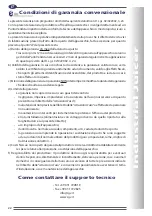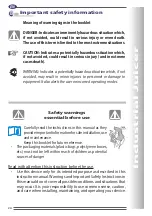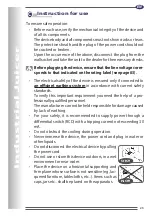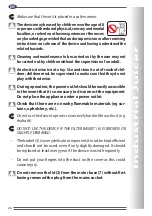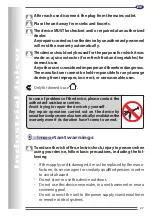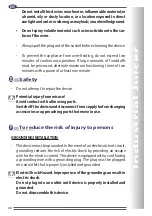
36
EN
I
ndustrial Juic
er
14. Switch the appliance off after use or when the collector container (4) or the containers
(12 and 13) are full.
15. Remove the lid (2) and clean the scraps.
After processing all the ingredients and after juice stopped leaking, turn the appliance
off and wait for the bucket (blade) (3) to stop rotating
.
16. After having processed all ingredients and when the juice has stopped escaping, lift the
spout (8), switch the appliance off and wait for the basket (blade) (3) to stop rotating.
When you press food with the tamper (1), the force exerted must be
continuous and uniform, but it must not exceed approximately 1 kg
and, in particular, it must not be sudden; otherwise, the pressing quality
won’t be satisfying.
After letting the appliance work for 2 minutes, pause it for 1 minute
(approximately), then restart using it.
17. After repeating this sequence 3 times pause for about 5 minutes and do not put the
appliance back to work until the motor cooled down; this way, the duration and effi-
ciency of the appliance will be prolonged and it’ll offer you a more efficient service.
Tips
1. Use fresh fruit and vegetables as they contain more juice. Pineapple, beets, celery stalks,
apples, cucumbers, carrots, spinaches, melons, tomatoes, pomegranates, oranges and
grapes are particularly suitable for centrifuge processing.
2. It is not necessary to remove thin skins. Only harder skins must be removed, like those
of oranges, pineapples and raw beets. Remove fruit nuts/seeds too, as they could have
a bad taste and damage the filter/grater disc.
3. When you prepare an apple juice, remember that apple juice density depends on the
type of apple too. Choose the type of apple which produces your favourite juice. Apple
juice darkens very quickly. To slow this process add a few drops of lemon juice.
4. Fruit which contains starch, such as bananas, papayas, avocados, figs and mangos, is
not suitable for centrifuge processing. Use a blender for these fruits.
5. Leaves and leaves stalks (for example lettuce) can be processed in the centrifuge too.
6. Drink juice immediately after extracting it. If it’s exposed to air even only for a little bit
of time, juice loses its taste and its nutritional value.
7. To extract the maximum juice quantity always press the tamper slowly.
8. The centrifuge is not suitable for processing very hard and/or fibrous/rich in starch fruits
and vegetables, such as sugar cane.
L

